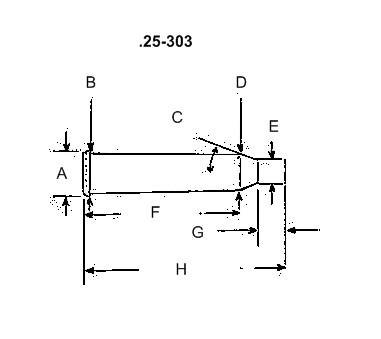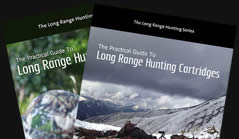History
The .25-303 first appeared in the 1930's when Australian wildcatters began looking for ways to utilize surplus military SMLE .303 rifles with worn bores. The .25 caliber was probably chosen due to America's interest in the .25 caliber at the time as well as its suitability for the light game generally hunted in Australia at that time. The popularity of this economical wildcat conversion grew and by the late 1940's factories were producing rifles and ammunition for it.
Factory loads were extremely low powered for the .25-303 featuring 87 grain bullets producing about 2650fps. With Kangaroo skins fetching good prices, the low velocity 87 grain load proved a good performer, producing minimum pelt damage and was also used to take thousands of goats and pigs. Due to a lack of interest, factories offered no load heavier than a 100 grain bullet at 2500fps. With the 87 grain bullet being the most popular bullet weight nearly all rifles converted to .25-303 featured a 1:12 twist.
Today, many examples of these rifles can be found throughout Australasia. The cartridge sees little use but often prompts discussion.
Performance
The .25-303 sits between the .250-3000 and .257 Roberts in terms of velocity and power.
Hand Loading
No manufacturer currently produces ammunition for the .25-303. Hand loads in 24" barrels utilizing modern slow burning (4350) powders produce substantially higher velocities than older factory loads. The 87 grain bullet can achieve speeds of up to 3100fps, the 100 grain bullet can be pushed to 3000fps and the 120 grain bullets will give 2700fps although this bullet weight requires a faster twist rate than commonly found on older rifles. Properly hand loaded, the .25-303 performs similarly to the .250-3000, .243 Winchester also older loadings for the .257 Roberts and the wildcat .25-08 (.25 Souper).
Closing Comments
The .303 was also necked to the .22 and .270 calibers. An improved version of the .25-303 created by Australian Sid Church, original owner of Taipan bullets, gave velocities approaching the .25-06. In recent times the .303 case has been necked up to .35 caliber in New Zealand.
| Suggested loads: .303-25 |
Barrel length: 24” |
| No |
ID |
|
Sectional Density |
Ballistic Coefficient |
Observed MV Fps |
ME
Ft-lb’s |
| 1 |
HL |
100gr G.King/Partition |
.216 |
.355 |
3000 |
1998 |
| 2 |
HL |
117gr Sierra GameKing |
.253 |
.410 |
2700 |
1894 |
| Suggested sight settings and bullet paths |
|
|
|
|
|
| 1 |
Yards |
100 |
150 |
263 |
305 |
325 |
350 |
375 |
|
| |
Bt. path |
+3 |
+3.6 |
0 |
-3 |
5.3 |
8.2 |
11.6 |
|
| 2 |
Yards |
100 |
150 |
235 |
270 |
300 |
325 |
350 |
|
| |
Bt. path |
+3 |
+3.2 |
0 |
-3 |
-5.8 |
-8.9 |
-12.5 |
|
| No |
At yards |
10mphXwind |
Velocity |
Ft-lb’s |
| 1 |
300 |
8.1 |
2253 |
1126 |
| 2 |
300 |
7.7 |
2107 |
1153 |
Note: Load No.2 may not stabilize in original twist rate barrels.

| |
Imperial |
Metric |
| A |
.540 |
13.72 |
| B |
.460 |
11.68 |
| C |
20deg |
|
| D |
.401 |
10.19 |
| E |
.257 |
6.53 |
| F |
1.790 |
45.47 |
| G |
.250 |
6.35 |
| H |
2.222 |
56.44 |
| Max Case |
2.222 |
56.44 |
| Trim length |
2.212 |
56.18 |
Discuss this article or ask a question on the forum here
Copyright © 2007-2017 Terminal Ballistics Research, Ballisticstudies.com







